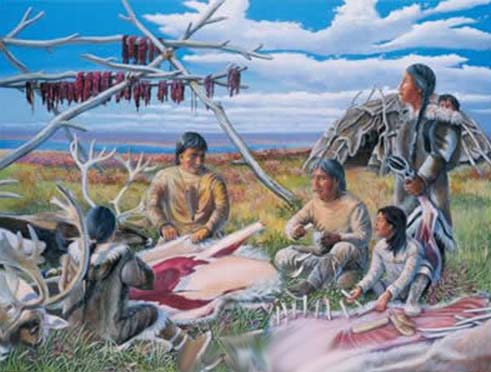
The culture is named for artifacts found near Clovis, New Mexico, where the first evidence of this tool complex was excavated in 1932. Earlier evidence included a mammoth skeleton with a spear-point in its ribs, found by a cowboy in 1926 near Folsom, New Mexico. Clovis sites have since been identified throughout all of the contiguous United States, as well as Mexico and Central America.
The Clovis people, also known as Paleo-Indians, are generally regarded as the the first human inhabitants of the New World, and ancestors of all the indigenous cultures of North and South America. However, this view has been recently contested by various archaeological finds which are claimed to be much older.
There are a number of controversial sites vying for the position of the earliest site in the region. The best evidence, however, suggests that a society of hunters and gatherers known as Clovis People were the first to settle in the Southwest, probably sometime before 9,500 B.C. The Clovis People were so named after the New Mexico town, site of the first discovery in 1932, near Clovis, N.M.
Since the mid 20th century, the standard theory among archaeologists has been that the Clovis people were the first inhabitants of the Americas. The primary support of the theory was that no solid evidence of pre-Clovis human inhabitation has been found. According to the standard accepted theory, the Clovis people crossed the Beringia land bridge over the Bering Strait from Siberia to Alaska during the period of lowered sea levels during the ice age, then made their way southward through an ice-free corridor east of the Rocky Mountains in present-day western Canada as the glaciers retreated.
The culture lasted for about a half a millennium, from about 11,200 to 10,900 years ago. People of the Clovis culture were successful, efficient big-game hunters and foragers. Judging from sites on the North American Great Plains, the Clovis people were skilled hunters of huge animals, especially Ice Age mammoths and mastodons.
It is generally accepted that Clovis people hunted mammoth: sites abound where Clovis points are found mixed in with mammoth remains. Whether they drove the mammoth to extinction via overhunting them - the so-called Pleistocene overkill hypothesis - is still an open, and controversial, question, keeping in mind that Archaeology is purely a theoretical endeavor.

























